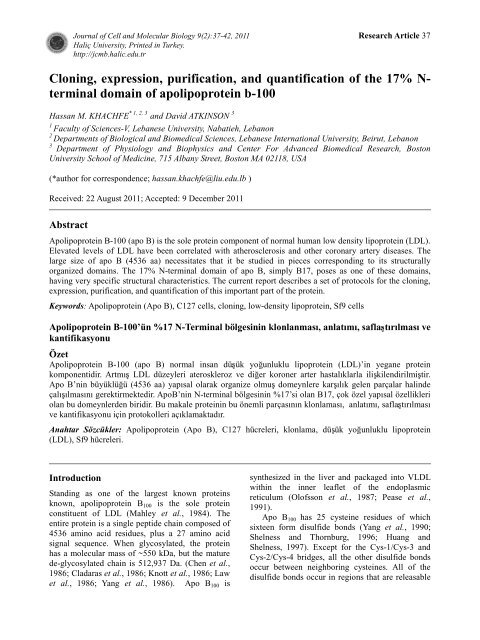Journal of Cell and Molecular Biology - ResearchGate
Journal of Cell and Molecular Biology - ResearchGate
Journal of Cell and Molecular Biology - ResearchGate
You also want an ePaper? Increase the reach of your titles
YUMPU automatically turns print PDFs into web optimized ePapers that Google loves.
<strong>Journal</strong> <strong>of</strong> <strong>Cell</strong> <strong>and</strong> <strong>Molecular</strong> <strong>Biology</strong> 9(2):37-42, 2011 Research Article 37<br />
Haliç University, Printed in Turkey.<br />
http://jcmb.halic.edu.tr<br />
Cloning, expression, purification, <strong>and</strong> quantification <strong>of</strong> the 17% Nterminal<br />
domain <strong>of</strong> apolipoprotein b-100<br />
Hassan M. KHACHFE * 1, 2, 3 <strong>and</strong> David ATKINSON 3<br />
1 Faculty <strong>of</strong> Sciences-V, Lebanese University, Nabatieh, Lebanon<br />
2 Departments <strong>of</strong> Biological <strong>and</strong> Biomedical Sciences, Lebanese International University, Beirut, Lebanon<br />
3 Department <strong>of</strong> Physiology <strong>and</strong> Biophysics <strong>and</strong> Center For Advanced Biomedical Research, Boston<br />
University School <strong>of</strong> Medicine, 715 Albany Street, Boston MA 02118, USA<br />
(*author for correspondence; hassan.khachfe@liu.edu.lb )<br />
Received: 22 August 2011; Accepted: 9 December 2011<br />
Abstract<br />
Apolipoprotein B-100 (apo B) is the sole protein component <strong>of</strong> normal human low density lipoprotein (LDL).<br />
Elevated levels <strong>of</strong> LDL have been correlated with atherosclerosis <strong>and</strong> other coronary artery diseases. The<br />
large size <strong>of</strong> apo B (4536 aa) necessitates that it be studied in pieces corresponding to its structurally<br />
organized domains. The 17% N-terminal domain <strong>of</strong> apo B, simply B17, poses as one <strong>of</strong> these domains,<br />
having very specific structural characteristics. The current report describes a set <strong>of</strong> protocols for the cloning,<br />
expression, purification, <strong>and</strong> quantification <strong>of</strong> this important part <strong>of</strong> the protein.<br />
Keywords: Apolipoprotein (Apo B), C127 cells, cloning, low-density lipoprotein, Sf9 cells<br />
Apolipoprotein B-100’ün %17 N-Terminal bölgesinin klonlanması, anlatımı, saflaştırılması ve<br />
kantifikasyonu<br />
Özet<br />
Apolipoprotein B-100 (apo B) normal insan düşük yoğunluklu lipoprotein (LDL)’in yegane protein<br />
Artmış komponentidir. LDL düzeyleri ateroskleroz ve diğer koroner arter hastalıklarla ilişkilendirilmiştir.<br />
Apo B’nin büyüklüğü (4536 aa) yapısal olarak olmuş organize domeynlere karşılık gelen parçalar halinde<br />
çalışılmasını gerektirmektedir. ApoB’nin N-terminal bölgesinin %17’si olan B17, çok özel yapısal özellikleri<br />
olan bu domeynlerden biridir. Bu makale proteinin bu önemli parçasının klonlaması, anlatımı, saflaştırılması<br />
ve kantifikasyonu için protokolleri açıklamaktadır.<br />
Anahtar Sözcükler: Apolipoprotein (Apo B), C127 hücreleri, klonlama, düşük yoğunluklu lipoprotein<br />
(LDL), Sf9 hücreleri.<br />
Introduction<br />
St<strong>and</strong>ing as one <strong>of</strong> the largest known proteins<br />
known, apolipoprotein B100 is the sole protein<br />
constituent <strong>of</strong> LDL (Mahley et al., 1984). The<br />
entire protein is a single peptide chain composed <strong>of</strong><br />
4536 amino acid residues, plus a 27 amino acid<br />
signal sequence. When glycosylated, the protein<br />
has a molecular mass <strong>of</strong> ~550 kDa, but the mature<br />
de-glycosylated chain is 512,937 Da. (Chen et al.,<br />
1986; Cladaras et al., 1986; Knott et al., 1986; Law<br />
et al., 1986; Yang et al., 1986). Apo B100 is<br />
synthesized in the liver <strong>and</strong> packaged into VLDL<br />
within the inner leaflet <strong>of</strong> the endoplasmic<br />
reticulum (Ol<strong>of</strong>sson et al., 1987; Pease et al.,<br />
1991).<br />
Apo B100 has 25 cysteine residues <strong>of</strong> which<br />
sixteen form disulfide bonds (Yang et al., 1990;<br />
Shelness <strong>and</strong> Thornburg, 1996; Huang <strong>and</strong><br />
Shelness, 1997). Except for the Cys-1/Cys-3 <strong>and</strong><br />
Cys-2/Cys-4 bridges, all the other disulfide bonds<br />
occur between neighboring cysteines. All <strong>of</strong> the<br />
disulfide bonds occur in regions that are releasable

















